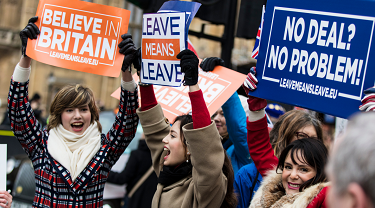
If you’re a Canadian exporter or investor currently doing business in the United Kingdom, you’re likely anxious about how Brexit will unfold. As the Apr. 12 exit deadline looms and talk of further extensions continue, there’s no doubt the eventual outcome will have an enormous impact on the U.K., its citizens and those conducting business with the island nation. For Canadian exporters, what exactly these impacts will be remains murky.
As Canada’s second-largest services trading partner, there’s much at stake. Overall, Canada’s exports to the U.K. totalled $17.7 billion in 2017, spanning many sectors, including mining and metals, aerospace and renewable energies. In order to break down the possible implications, Export Development Canada (EDC) is hosting a webinar on Apr. 2. EDC’s panel of experts will offer their insights and perspectives to help you understand how Brexit will affect business interests and supply chains and offer strategies for mitigating Brexit’s impact on your business.
In the meantime, we’ll look at where things stand currently in the Brexit process and shed light on what happens next.
How did we get here?
Tapping into a rise of populism sweeping across Europe and a growing mistrust of institutional power, British voters stunned pundits and pollsters by handing the “Leave” side a slim yet decisive victory to exit the European Union in the Brexit referendum on June 23, 2016. Without a clear plan in place, U.K. Prime Minister Theresa May officially set the wheels in motion on the Brexit process on Mar. 29, 2017. Since then, May has been working to negotiate a withdrawal agreement with the EU and get it approved by an increasingly divided and fractious Parliament.
On Jan. 15, 2019, May tried for the first time to get her agreement with the EU approved in Parliament, but was resoundingly defeated by 230 votes. She was then tasked with going back to the negotiating table in Brussels, the de facto capital of the EU, to make the proposed deal more palatable to its opponents.
On Mar. 12, May went back to the British Parliament with roughly the same withdrawal agreement in hand, alongside legal assurances from the EU that the U.K. would not remain in the EU indefinitely due to the “Irish backstop,” which effectively is an insurance policy in the Brexit negotiations meant to ensure that the Irish border on the island remains open—as it is today. Despite the changes, the agreement was again defeated by a narrower margin of 149 votes. On Mar. 13, Parliament voted against any chance of a “no-deal Brexit”—in which the U.K. leaves the EU with no agreement in place. On Mar. 14, lawmakers voted to delay the Brexit process.
A third vote initially planned for Mar. 20, was delayed by the Speaker of the House, who informed May that Parliament could only vote on a “substantially” revised proposal. Although May was working behind the scenes to gather support from MPs that had previously voted against her deal, securing a win seemed unlikely one week after the last vote. And now, the decision tree has been changed. It’s expected that May will head back to Brussels to seek an extension to Article 50 (a legal right allowing any member country to withdraw from the EU voluntarily) and the duration will depend on what MPs feel is needed and reasonable.
If May manages to secure her deal by proposing a substantial change, she’ll likely seek a short extension from Brussels to June 30. But if she fails to secure the deal, she’s expected to ask Brussels for a longer extension. Yet, there remains the risk that the U.K. exits the EU Apr. 12 with no deal.

Terms of the Brexit agreement
The current withdrawal agreement negotiated by the prime minister sets out four main elements of the U.K.’s exit from the EU.
- The U.K. must pay the EU 39 billion pounds (C$69 billion) to fulfil its obligations to the EU budget through the end of a transition period.
- This 21-month transition period is significant because the withdrawal agreement doesn’t cover the future relationship between the U.K. and the EU in terms of trade in goods and services. It’s during the transition period that a new trade agreement with the EU needs to be negotiated and put in place.
- Citizens’ rights is an area of concern. The agreement preserves the residency and social security rights of EU citizens in the U.K. and U.K. citizens in the EU. However, despite these safeguards, it doesn’t clearly address the free movement of labour between countries post-Brexit.
- The most controversial aspect of the agreement is the “backstop.” Currently, the nearly 500-kilometre border between Northern Ireland and the Republic of Ireland is the U.K.’s only physical border with the EU. Under the terms of the agreement, the backstop remains in place, ensuring an open border until a solution is found to ensure that a physical border isn’t necessary. The backstop is intended as a safety net to ensure that a hard border won’t be put in place as a result of future trade negotiations between the U.K. and the EU.
Many MPs are against the backstop because they’re concerned that it may leave the U.K. tied to the EU indefinitely and may limit its options for future trade negotiations. There’s also concern that the reinstatement of a hard border between the two countries could inflame sectarian tensions that have been quiet since the 1998 Good Friday Agreement.
The end may not be in sight
Even if May’s deal or a variation of it gets accepted, there are still hurdles to clear.
- The U.K. will now enter the transition period wherein the terms of a new trade agreement will need to be negotiated with the EU. The trade agreement will need to be ratified by the U.K. Parliament and all 27 EU member states. This has implications for trade deals with a third-party country, like Canada, that already has an agreement with the EU.
- The U.K. will now need to consider its political voice and role in terms of the EU and international bodies, like the North Atlantic Treaty Organization (NATO), the UN and so on. By leaving the EU, the U.K.’s bargaining power throughout the globe will be negatively impacted, which may affect its relations with third-party countries.
- The Brexit debate in the U.K. will likely not abate if May’s deal passes as the public remains roughly divided on the topic. The initial referendum provided a slim majority to “leave,” and recent polls suggest there’s a slim majority to “remain.” Furthermore, it will take three votes to pass May’s deal, which suggests that there’s limited support by MPs for the current deal.
Implications for Canadian exporters
While the political process continues, Canadians exporting to the U.K. have good reason to be concerned about the economic fallout from Brexit, regardless of the outcome. A recent study from the Bank of England forecasts that following a “disorderly Brexit,” the U.K. economy could be as much as 8% weaker over the medium term and the pound could fall by 25% against the U.S. dollar (both relative to their pre-Brexit trends). A no-deal Brexit would also likely result in high tariffs following the rules of the World Trade Organization.
Even with a relatively smooth Brexit, exporters face uncertainty. For example, EDC research indicates that businesses that depend on the movement of physical goods, including those in the automotive, pharmaceutical, aerospace and capital goods industries will face shipping challenges. Customs delays at ports and border crossings are likely for goods travelling into and out of the U.K., as new procedures are put in place, and customs officials are hired and trained. These delays will likewise be a concern for exporters who are feeding into a supply chain in one of these sectors.
Despite some of the potentially negative consequences in the aftermath of Brexit, there’s also reason for optimism and the potential for new opportunities to emerge for Canadian exporters in Europe and beyond. To learn more, check out our on demand webinar on Apr. 2.






